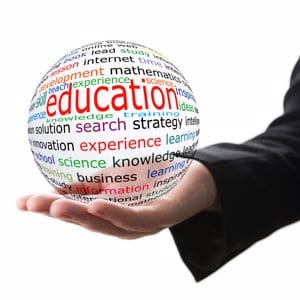Developing effective marketing strategies within the modern educational landscape relies heavily on understanding schools’ diverse components and decision-makers—not to mention their unique needs and priorities. To thrive in the sector, businesses require enhanced outreach efforts that not only resonate with educators’ challenges but also align with the school’s purchasing cycle.
Explore the methodologies and technology-driven solutions your business can embrace to refine your sales and marketing approach—fostering trust and relevance with your target audiences. Equipped with innovative approaches and deep industry knowledge, you can confidently forge strong connections and leave a lasting impact.
What Is School Marketing?
School marketing refers to the strategies used by solution providers to connect with schools, teachers, and administrators. It involves promoting tools and services that genuinely support school operations. These efforts go beyond sales to build trust and show value—delivering solutions that meet the specific needs of educators and their students.
Why It Matters for Solution Providers
School leaders are busy, selective, and focused on finding real solutions, not just products. A smart marketing strategy helps cut through the noise and positions brands as trusted partners. It’s the key to reaching the right people at the right time with a message that resonates.
School Decision-Makers and How To Reach Them
Navigating the modern education sector requires a firm understanding of its diverse components and the important role of key decision-makers. Educational ecosystems include a considerable number of institutions, ranging from public schools to private academies—each with its own set of needs and priorities.
Who are some of the primary decision-makers influencing the school purchasing cycle within these landscapes?
- Administrators
- Curriculum directors
- Teachers
- Technology coordinators
- Finance officers
Understanding each stakeholder’s unique role, perspectives, and goals is crucial for crafting effective marketing efforts that resonate with their objectives. This approach encourages more meaningful engagements and nurtures long-lasting partnerships.
When Do Schools Buy?
The school purchasing cycle itself is a multifaceted process, often guided by curriculum requirements and evolving educational trends; not to mention tight budget constraints. Education Data Initiative underscores this complexity, revealing a $15.3 billion gap between spending and funding—the equivalent of $310 per student. Purchasing behaviors also change significantly from one district to another, which demands adaptable marketing initiatives. Consequently, your target audience is more likely to notice and adopt offerings that align with the school’s procurement systems.
Practical Ways To Market To Teachers
Teachers—from K–12 educators and online instructors to college faculty—are a powerful audience in school marketing. They can influence purchasing decisions and often shape what tools and resources schools adopt.
Here are practical ways to engage educators effectively:
- Leverage social channels: Create Facebook groups or use other social platforms to connect with teachers where they already engage. Share free resources, promote webinars, and encourage newsletter signups to build trust and community.
- Avoid buzzwords: Teachers appreciate clear, straightforward messaging that speaks to their real needs. Focus on practical benefits, like free lesson plans or webinars, and avoid vague or overused marketing language.
- Use data-driven insights: Use data from partners like Agile Education Marketing or resources such as Google for Education to better understand teacher priorities. Tailor email campaigns and content to deliver relevant, timely solutions they’ll value.
- Consider budgets and financial constraints: Educators often face tight budgets, so offer discounts, free trials, or referral rewards to increase accessibility. Add value with downloadable resources or free training sessions shared via email or social media.
- Know your audience: Partner with trusted teacher influencers to co-host webinars and create authentic content. These collaborations boost credibility and help expand your reach through email, social, and word-of-mouth marketing.
5 Strategies To Improve School Marketing Campaigns
Try these strategies to boost your overall marketing impact and connect better with school leaders:
1. Use Digital Channels for School Outreach
A K-12 Dive survey shows 30% of teachers now rely on commercial digital materials. Using digital platforms lets you connect with schools and key decision-makers in real time, widening your reach and strengthening your message.
Make sure your content is engaging, ads are targeted, and your website is easy to use and search-friendly. To build strong connections with school administrators and educators, use channels such as:
- Email marketing
- Social media engagement
- Interactive webinars
- Online advertising
- Video marketing
2. Reach the Right Audience, at the Right Time
Detailed market research helps you identify stakeholders’ needs and the best time to reach them. Effective strategies include:
- Using data analytics to find the optimal timing for marketing campaigns.
- Tailoring messages to address stakeholders’ immediate challenges.
- Aligning outreach with schools’ buying cycles to make campaigns more relevant and build stronger connections.
Personalized, timely offers can give your business a competitive edge, considering 76% of consumers are more likely to buy from brands that customize solutions, per McKinsey.
3. Craft Content That Resonates
To create content that truly connects with education decision-makers, focus on the unique needs and challenges schools face. Tailor your content to address educators’ concerns using a mix of engaging articles, videos, case studies, infographics, and more. This not only grabs attention but also builds credibility.
4. Personalize Your Offerings
According to Google, 90% of marketers say personalization significantly boosts business profitability. To make your offerings more relevant, use market research to understand your audience’s needs, preferences, and buying habits. Then, apply feedback and data to refine and personalize your offerings. Customized solutions not only attract buyers but also increase customer satisfaction and loyalty.
5. Let Education Data Guide Your Strategy
Education data can transform your marketing strategy by helping you understand your audience’s needs and buying habits. Spotting trends and patterns allows you to tailor your messaging, content, and offers to better connect with schools. To get the most from this approach:
- Invest in data analytics tools
- Regularly review and audit your data
- Work with schools and key partners (e.g., advisory boards or research groups)
Build Credibility With School Leaders
Forge meaningful connections with schools and stakeholders to facilitate remarkable educational outcomes. By nurturing relationships, your business gains insights into schools’ specific demands and challenges. Collaboration and trust enable tailored solutions that resonate with educators and administrators at the right time in their purchasing cycle.
With stronger bonds in place, it’s simpler to boost your outreach initiatives and ultimately enhance the educational experience for students and educators alike. Incorporate the following tips in your digital marketing strategy to strengthen your long-term relationships with schools:
- Keep communication clear: Be open and honest in all your communications to build trust.
- Focus on solutions that bring value: Provide educational services and products that adequately address the needs of schools and bring measurable benefits.
- Share success stories: Demonstrate how your solutions have helped other private or public schools with testimonials and case studies.
- Provide excellent customer support: Be there for schools when they need help, and resolve issues quickly.
- Get to know each school’s needs: Take the time to understand what each district, school, or stakeholder needs and tailor your offerings accordingly.
- Build personal connections: Foster relationships with key educational influencers you work with, so they feel comfortable and confident in your partnership.
- Consistently deliver quality: Make sure your products and services always meet or exceed expectations.
- Stay updated: Keep up with what’s happening in the sector so that you can provide the latest and most relevant solutions.
- Offer training and resources: Help schools get the most out of your solutions by providing training and useful resources.
- Listen and improve: Regularly ask for feedback from decision-makers and use it to improve your solutions and services.
Target the Right Audience and Improve Communication
According to Trustmary, 80% of content marketing targets the wrong audience. To craft the most effective content marketing strategy, consider the different levels where educational decisions take place. In school districts, leaders like superintendents and school boards play crucial roles in purchasing choices. At the school level, principals and administrators are regarded as influential decision-makers. Moreover, within departments, curriculum directors and tech coordinators have a say in specific areas—for example, instructional materials and technology.
Understanding these hierarchies is vital for providing solutions that meet the requirements of your target audience. Plus, tailored offerings for educational influencers empower your business to make a more significant impact in the education sector.
Explore a few strategies for enhancing your educational audience research and ensuring your marketing activities align with a school’s needs:
- Conduct surveys and feedback sessions: Gather valuable insights by conducting surveys, polls, and feedback sessions to fully comprehend your audience’s preferences, pain points, and expectations.
- Monitor social media channels: Educational influencers are increasingly searching for solutions online. Take advantage of this trend by monitoring conversations and engagement on social media platforms to gain real-time feedback and identify emerging trends.
- Explore competitor analysis: Look into what competitors are offering, including marketing strategies and customer feedback, to recognize gaps in the market and opportunities for differentiation.
- Utilize education data analytics tools: Leverage robust data analytics tools to analyze education market data and purchasing trends; to better understand the preferences of your target audience.
- Stay updated on industry trends: Keep up with important educational trends, emerging technologies, and regulatory changes that may impact your audience’s preferences and behavior.
- Invest in market research tools: Consider investing in market research tools and services, such as AgileInsight or eProfile, that provide comprehensive data and analysis. This informs strategic decision-making and digital marketing activities.
Take Advantage of Emerging Technologies
Turn to cutting-edge technologies to elevate your direct marketing and outreach efforts moving forward. With innovations such as artificial intelligence, data analytics, and automation, you can precisely target your educational audience, personalize interactions, and analyze marketing campaign performance in real time. This shift toward tech-driven solutions is a result of:
- Evolving consumer behaviors
- Competitive landscapes
- The pursuit of maximum ROI
Harnessing these advancements leads to enhanced brand awareness and stronger connections with key educational decision-makers. Embracing technology is no longer just a choice—it’s a strategic necessity for thriving in today’s dynamic educational landscape.
The Benefits of Advanced Technology in School Marketing
Here are a few ways to maximize your use of digital solutions and improve your school marketing plan:
- Implement marketing automation: Marketing automation tools tailored to educational contexts streamline outreach initiatives and help maintain consistent communication with critical stakeholders. This fosters stronger relationships in the long run.
- Integrate CRM systems: Incorporate customer relationship management (CRM) systems to centralize data and track interactions more effectively. CRM systems empower personalized communication and targeted marketing efforts.
- Leverage education data services: Access education-specific data solutions offering insights into school procurement influencers’ unique needs, sector trends, and market demand for educational services. This enables your business to make data-driven decisions, identify emerging opportunities, and customize offerings as needed.
How To Measure School Marketing Efforts
Nearly 72% of organizations describe their marketing performance measurements as average or below, according to Agility PR Solutions. However, evaluating your outreach initiatives is critical for continuous improvement and effectiveness. It’s all about understanding what works and what doesn’t, so you can fine-tune your approach. This encompasses insights that help you connect better with the most relevant educational audience, at the right time.
Regular assessments keep marketing efforts on track, boost your returns, and ensure you stay ahead of the curve in the sector. With flexibility, innovation, and success in mind, make every marketing campaign count with the following evaluation metrics:
- Website traffic: Monitor the number of visitors to your site, considering metrics like page views, bounce rate, and time spent on the website. Use this to gauge the effectiveness of your online presence and content.
- Conversion rate: Monitor the percentage of website visitors who take action, such as filling out a contact form, downloading a resource, or signing up for a webinar. A higher conversion rate tells you that you’re doing something right.
- Lead generation: Measure the number—and quality—of leads generated through different marketing channels. This might include website forms, email sign-ups, or social media inquiries. To refine targeting strategies, assess your lead demographics, interests, and engagement.
- Email marketing engagement: Look at email open rates, click-through rates, and conversion rates to appraise the results of your email marketing campaigns. Monitoring subscriber growth and unsubscribe rates is a useful approach to measuring audience interest and satisfaction.
- Social media engagement: Follow metrics such as likes, shares, comments, and followers across every social media platform used. This involves tracking engagement trends, audience demographics, and content performance to optimize your social media strategies.
- Content performance: Review the performance of your blog posts, articles, videos, and other assets by tracking metrics. Identifying top-performing topics can inform future content-creation efforts.
School Marketing FAQs
How do teachers typically discover new educational solutions?
Teachers often discover new tools through trusted recommendations from peers, professional development events, and active online communities. They also rely on respected education influencers to find solutions that really work.
What kind of content do teachers find most valuable?
Free lesson plans, easy-to-use resources, and clear how-to guides are great ways to catch teachers’ attention. They especially appreciate case studies that show real results in the classroom.
Should I use informal language when marketing to teachers?
A warm, friendly tone is a great way to connect, but keeping it professional shows respect for their challenges. Focus on solving real problems and highlighting benefits—teachers value honesty and relevance over flashy sales talk.
What are the best times of year to launch a teacher-focused campaign?
Late spring and early fall are prime moments when teachers are planning and gearing up for a new year. That’s when they’re most open to discovering fresh tools and ideas.
How important are teacher testimonials in marketing materials?
Teacher testimonials are incredibly powerful—nothing beats hearing success stories from real educators. Authentic peer reviews build trust and influence decision-making far more than traditional ads.
Empower Your School Marketing With Agile Education Marketing
Boost your school marketing strategies with Agile Education Marketing. Agile provides comprehensive and continuously updated education data, ensuring your outreach is precise and effective. Plus, with expertise spanning K-12, Higher Education, At-Home education, and more, you receive year-round updates capturing critical changes in district demographics and personnel. Our meticulous methodology and diverse education data categories set us apart, offering detailed insights into educational segments that are most relevant to your marketing goals:
- Seamlessly access valuable information through Agile’s integration and data products, including Prospector Lists On Demand and Data Explorer.
- Leverage our expert data management support services for optimized outreach strategies.
- Utilize Agile’s omni-channel marketing approach, incorporating email marketing, social media, digital advertising, and more, to engage with educators at every touchpoint.
With Agile Education Marketing by your side, you can effectively refine your marketing initiatives, connect with your target audience, and drive meaningful results in the education sector. Partner with us to empower your school marketing efforts and unlock new opportunities for growth and success.
Want to learn more? Download our Digital Marketing + Advertising Playbook!



